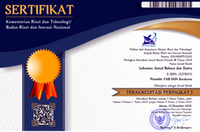GRAMMATICAL COHESION IN STUDENTS' WRITING: A CASE AT UNIVERSITAS TEKNOKRAT INDONESIA
DOI:
https://doi.org/10.22515/ljbs.v2i2.899Keywords:
discourse analysis, cohesion, grammatical cohesion, semantic relationAbstract
This research aims at investigating the type of cohesive devices in students’ writing as a part of discourse analysis. Thus, it explores sentence correlation and meaning as a whole discourse and figures out inappropriate use of the devices.This research is conducted qualitatively to the students of English Letters of Universitas Teknokrat Indonesia Bandar Lampung and employs Halliday and Hasan’s (1976) conceptual framework. Further, examining the grammatical cohesion through document, this research deeply looks at the data in form of sentences. The researcher found 122 grammatical cohesive devices from three essays. Furthermore, the researcher also found 5 inappropriate uses of cohesive devices; it includes 2 additive conjunctions, 2 adversative conjunctions, and 1 temporal conjunction. It is also noted that the lacking understanding and awareness about cohesion especially on grammatical cohesion leads the students to use inappropriate cohesive devices. It then problematizes the semantic relation among ideas in the text. Thus, this research comes up with a feedback to the lecturer that the discussion of coherence and cohesion should be more intensive.
References
Astuti, KS. 2012. Kohesi Wacana Politik Pada Rubrik Opini Surat Kabar Harian Kedaulatan Rakyat. (Undergraduate Thesis). Yogyakarta: Universitas Negeri Yogyakarta
Berzlánovich, I. 2008. Lexical Cohesion and the Organization of Discourse.Center for Language and Cognition. Groningen: University of Groningen
Blakemore, D. 2001. The Handbook of Discourse Analysis. Malden: Blackwell Publishers Inc.
Cutting, J. 2002. Pragmatics and Discourse: A Resource Book for Students. Oxon: Routledge
Farag, L. 2016. Coherence and Cohesion in Academic Writing. http://www.tesol.org/ connect/teso-resource-center/search-detail/lesson-plans/2013/08/23/ coherence-and-cohesion-in-academic-writing.2013. Acessed on June 2016
Halliday, MAK & Ruqaiya Hasan. 1976. Cohesion in English. London: Longman
Husein, Husein Maghawry. 2014. A Corpus-based Discourse Analysis of Grammatical Cohesive Used in Epository Essays Written by Emirati EFL Learners at Al ghazali School, Abu Dhabi. (PhD Dissertation). Dubai: The British University
Jacobs, HL, SA Zinkgraf, DR Wormuth, , VF Hartfiel, & JB Hughey. 1981. Testing ESL Composition: a practical approach. Rowley: Newbury House
Klimova, Blanka F & Hubackova, Sarka. 2014. “Grammatical Cohesion in Abstractsâ€. Procedia-Social and Behavioral Sciences, 116: 664-668
Kuncahya, Astri Ollivia. 2015. Cohesion in Narrative Texts Presented in the Electronic Textbook of Senior High School Grade X Entitled Developing English Competence.(Undergraduate Thesis. Yogyakarta: Universitas Negeri Yogyakarta
Nunan, David. 1993. Introducing Discourse Analysis. London: Penguin English
Nurhayati, Yanti. 2012. The Error Analysis on the Use of Cohesive Devices in English Writing Essay among the Seventh Semester Students of English Department of STAIN Salatiga in the Academic Year of 2011/2012. (Undergraduate Thesis). Salatiga: STAIN Salatiga
Parazaran, Saeed & Seyyed M. Motahari,. 2015. “Investigating Grammatical Cohesive Devices: Shift of Coherence in Translating Narrative Text Typeâ€. International Journal of Foreign Language Teaching and Research, 3 (10)
Patton, MQ & Michael Cochran. 2002. A Guide to Using Qualitative Research Methodology. Medecins Sans Frontieres
Rocci, A. 2009. Discourse: An Overview of Research in Discourse Studies. Amsterdam: John Benjamins Publishing Co.
Schiffrin, et. al. 2001. The Handbook of Discourse Analysis. Malden: Blackwell Publishers Inc.
Stake, Robert E. 2010. Qualitative Research-Studying How Things Work. New York: The Guilford Press
Downloads
Published
Issue
Section
License
The copyright of the received article shall be assigned to the publisher of the journal. The intended copyright includes the right to publish the article in various forms (including reprints). The journal maintains the publishing rights to published articles.
In line with the license, the authors and users (readers or other researchers) are allowed to share and adapt the material only for non-commercial purposes. In addition, the material must be given appropriate credit, provided with a link to the license, and indicated if changes were made. If authors remix, transform or build upon the material, authors must distribute their contributions under the same license as the original.







